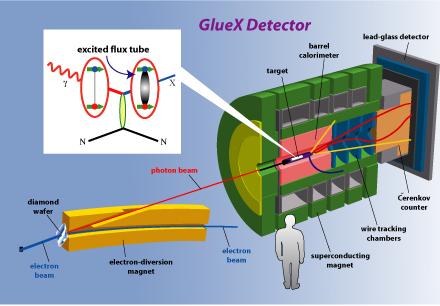| |
The inset in the above figure illustrates the physics concept that
underlies the GlueX experiment. The photon coming in from the upper left
is thought to turn into a pair of quarks through quantum fluctuations.
The quarks are some distance apart but are strongly attracted to each other
through a force that can be represented by an elastic string called
a gluonic flux tube. The quark pair then scatters from the
incoming proton (labeled N in the figure) by the exchange of a
virtual mediating particle (vertical yellow band in the figure) and
emerges as a quark-antiquark bound state (labeled X).
In some cases, the flux tube binding the quark-antiquark
pair together is expected to vibrate. Such excited states are very
short-lived, but the energy and other quantum signatures of the excited
flux tube are imprinted on the pattern of final-state particles that emerge
from the reaction and are measured in the detector. The complex process
of deciphering the final-state pattern and finding the excitation spectrum
that produced it is known as Partial Wave Analysis.
|
